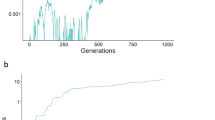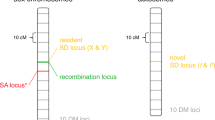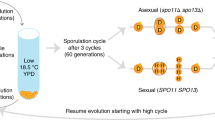Abstract
SEXUAL reproduction confronts evolutionary biology with a paradox: other things being equal, an asexual (all-female) population will have twice the reproductive potential of a competing sexual population and therefore should rapidly drive the sexual population to extinction1,2. Thus, the persistence of sexual reproduction in most life forms implies a compensatory advantage to sexual reproduction. Work on this problem has emphasized the evolutionary advantages produced by the genetic recombination that accompanies sexual reproduction1–7. Here we show that genetic segregation produces an advantage to sexual reproduction even in the absence of an advantage from recombination. Segregation in a diploid sexual population allows selection to carry a single advantageous mutation to a homozygous state, whereas two separate mutations are required in a parthenogenetic population. The complete fixation of advantageous mutations is thus delayed in a heterozygous state in asexual populations. Calculation of the selective load incurred suggests that it may offset the intrinsic twofold reproductive advantage of asexual reproduction and maintain sexual reproduction in diploid populations.
This is a preview of subscription content, access via your institution
Access options
Subscribe to this journal
Receive 51 print issues and online access
$199.00 per year
only $3.90 per issue
Buy this article
- Purchase on Springer Link
- Instant access to full article PDF
Prices may be subject to local taxes which are calculated during checkout
Similar content being viewed by others
References
Williams, G. C. Sex and Evolution (Princeton University Press, 1975).
Maynard Smith, J. The Evolution of Sex (Cambridge University Press, 1978).
Fisher, R. A. The Genetical Theory of Natural Selection, 2nd edn (Dover, New York, 1958).
Muller, H. J. Am. Nat. 66, 118–138 (1932).
Michod, R. E. & Levin, B. R. (eds) The Evolution of Sex: an Examination of Current Ideas (Sinauer, Sunderland, Massachusetts, 1988).
Kondrashov, A. S. Nature 336, 435–440 (1988).
Bell, G. The Masterpiece of Nature (University of California Press, Berkeley, 1982).
Author information
Authors and Affiliations
Rights and permissions
About this article
Cite this article
Kirkpatrick, M., Jenkins, C. Genetic segregation and the maintenance of sexual reproduction. Nature 339, 300–301 (1989). https://doi.org/10.1038/339300a0
Received:
Accepted:
Issue Date:
DOI: https://doi.org/10.1038/339300a0
This article is cited by
-
The power of randomization by sex in multilocus genetic evolution
Biology Direct (2020)
-
Loss-of-heterozygosity facilitates passage through Haldane’s sieve for Saccharomyces cerevisiae undergoing adaptation
Nature Communications (2014)
-
The maintenance of sex: Ronald Fisher meets the Red Queen
BMC Evolutionary Biology (2013)
-
Genetic diversity and fitness in small populations of partially asexual, self-incompatible plants
Heredity (2010)
-
The asexual ploidy cycle and the origin of sex
Nature (1994)
Comments
By submitting a comment you agree to abide by our Terms and Community Guidelines. If you find something abusive or that does not comply with our terms or guidelines please flag it as inappropriate.



